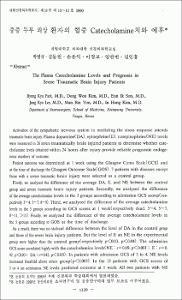KUMEL Repository
1. Journal Papers (연구논문)
1. School of Medicine (의과대학)
Dept. of Neurosurgery (신경외과학)
중증 두부 외상 환자의 혈중 Catecholamine치와 예후
- Keimyung Author(s)
- Kim, Dong Won; Son, Eun Ik; Lee, Jung Kyo; Yim, Man Bin; Kim, In Hong
- Department
- Dept. of Neurosurgery (신경외과학)
- Journal Title
- 대한신경외과학회지
- Issued Date
- 1990
- Volume
- 19
- Issue
- 10~12
- Abstract
- Activation of the sympathetic nervous system in mediating the stress response attends traumatic brain injury. Plasma dopamine(DA), epinephrine(E), norepinephrine(NE) levels were measured in 26 severe traumatically brain injured patients to determine whether catecholamine levels obtained within 24 hours after injury provide reliable prognostic endogenous markers of outcome.
Patient outcome was determined at 1 week using the Glasgow Coma Scale(GCS) and at the time of discharge the Glasgow Outcome Scale(GOS). 7 patients with diseases except those with a severe traumatic brain injury were selected as a control group.
Firstly, we analyzed the difference of the average DA, E, and NE between the control group and severe traumatic brain injury patients. Secondly, we analyzed the difference of the average catecholamine levels in the 3 groups according to admission GCS scores(respectively 3∼4, 5∼7, 8∼9). Third, we analyzed the difference of the average catecholamine levels in the 5 groups according to GCS scores at 1 week(respectively dead. 3∼4. 5∼7.8∼11, >11). Finally, we analyzed the difference of the average catecholamine levels in the 5 groups according to GOS at the time of discharge.
As a result, there was no statical difference between the level of DA in the control grop and those of the severe brain injury patients. But the level of E an NE in the experimental group were higher than the control group(respectively p<0.03. p<0.04). The admission GCS score correlated highly with the catecholamine levels(NE : r= 0.69, p<0.001 : E : r=0.42. p<0.03 ; DA ; r= 0.42. p<0.03). In patients with admission GCS of 3 to 4, NE levels increased fourfold above other group(p<0.005). In the 13 patients with GCS scores of 3 or 4 on admission. NE levels predicted outcome at 1 week. All two patients with NE levels less then 750 pg/㎖ were survived, while 10 of 11 with NE levels greater than 750 pg/㎖ were died(p<0.02). The levels of NE was significantly higher in patients who died than in those with better outcome(p<0.02).
Therefore, these findings indicated that the level of circulating NE is an excellent endogenous marker that appear to reflect the extent of brain injury and that may predict the likelihood of recovery.
계명대학교 동산의료원 신경외과에 입원 가료한 중증 두부 외산 환자 26례를 대상으로 입원 당시 혈중 catecholamine을 측정하여 외상 정도와 예후와의 관계를 조사한 바 채혈 당시 GCS가 낮은 환자에서 GCS가 높은 환자보다 NE이 유의하게 높았으며 GCS 3~4군 13례중 NE이 750 pg/㎖이상인 11례중 10례가 1주일후 모두 사망하여 GCS 3~4군에서 1주일후 예후를 예측할 수 있었으며 퇴원시 사망한 군에서 사망하지 않은 군보다 NE이 유의하게 높았다.
그러므로 중증 두부 외상 환자에서의 외상 정도와 예후 예측에 혈중 NE의 측정이 좋은 내인성지표가 될 것으로 사료된다.
- Alternative Title
- The Plasma Catecholamine Levels and Prognosis in Severe Traumatic Brain Injury Patients
- Publisher
- School of Medicine
- Citation
- 박병규 et al. (1990). 중증 두부 외상 환자의 혈중 Catecholamine치와 예후. 대한신경외과학회지, 19(10~12), 1329–1338.
- Type
- Article
- ISSN
- 1225-8245
- Appears in Collections:
- 1. School of Medicine (의과대학) > Dept. of Neurosurgery (신경외과학)
- 파일 목록
-
-
Download
 oak-bbb-1613.pdf
기타 데이터 / 2.1 MB / Adobe PDF
oak-bbb-1613.pdf
기타 데이터 / 2.1 MB / Adobe PDF
-
Items in Repository are protected by copyright, with all rights reserved, unless otherwise indicated.